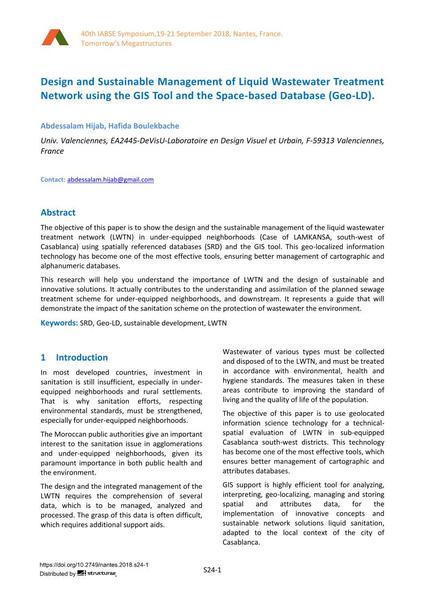Design and Sustainable Management of Liquid Wastewater Treatment Network using the GIS Tool and the Space-based Database (Geo-LD).

|
|
|||||||||||
Détails bibliographiques
| Auteur(s): |
Abdessalam Hijab
(Univ. Valenciennes, EA2445-DeVisU-Laboratoire en Design Visuel et Urbain, F-59313 Valenciennes, France)
Hafida Boulekbache (Univ. Valenciennes, EA2445-DeVisU-Laboratoire en Design Visuel et Urbain, F-59313 Valenciennes, France) |
||||
|---|---|---|---|---|---|
| Médium: | papier de conférence | ||||
| Langue(s): | anglais | ||||
| Conférence: | IABSE Symposium: Tomorrow’s Megastructures, Nantes, France, 19-21 September 2018 | ||||
| Publié dans: | IABSE Symposium Nantes 2018 | ||||
|
|||||
| Page(s): | S24-1 | ||||
| Nombre total de pages (du PDF): | 7 | ||||
| DOI: | 10.2749/nantes.2018.s24-1 | ||||
| Abstrait: |
The objective of this paper is to show the design and the sustainable management of the liquid wastewater treatment network (LWTN) in under-equipped neighborhoods (Case of LAMKANSA, south-west of Casablanca) using spatially referenced databases (SRD) and the GIS tool. This geo-localized information technology has become one of the most effective tools, ensuring better management of cartographic and alphanumeric databases. This research will help you understand the importance of LWTN and the design of sustainable and innovative solutions. It actually contributes to the understanding and assimilation of the planned sewage treatment scheme for under-equipped neighborhoods, and downstream. It represents a guide that will demonstrate the impact of the sanitation scheme on the protection of wastewater the environment. |
||||
| Mots-clé: |
développement durable
|
||||
